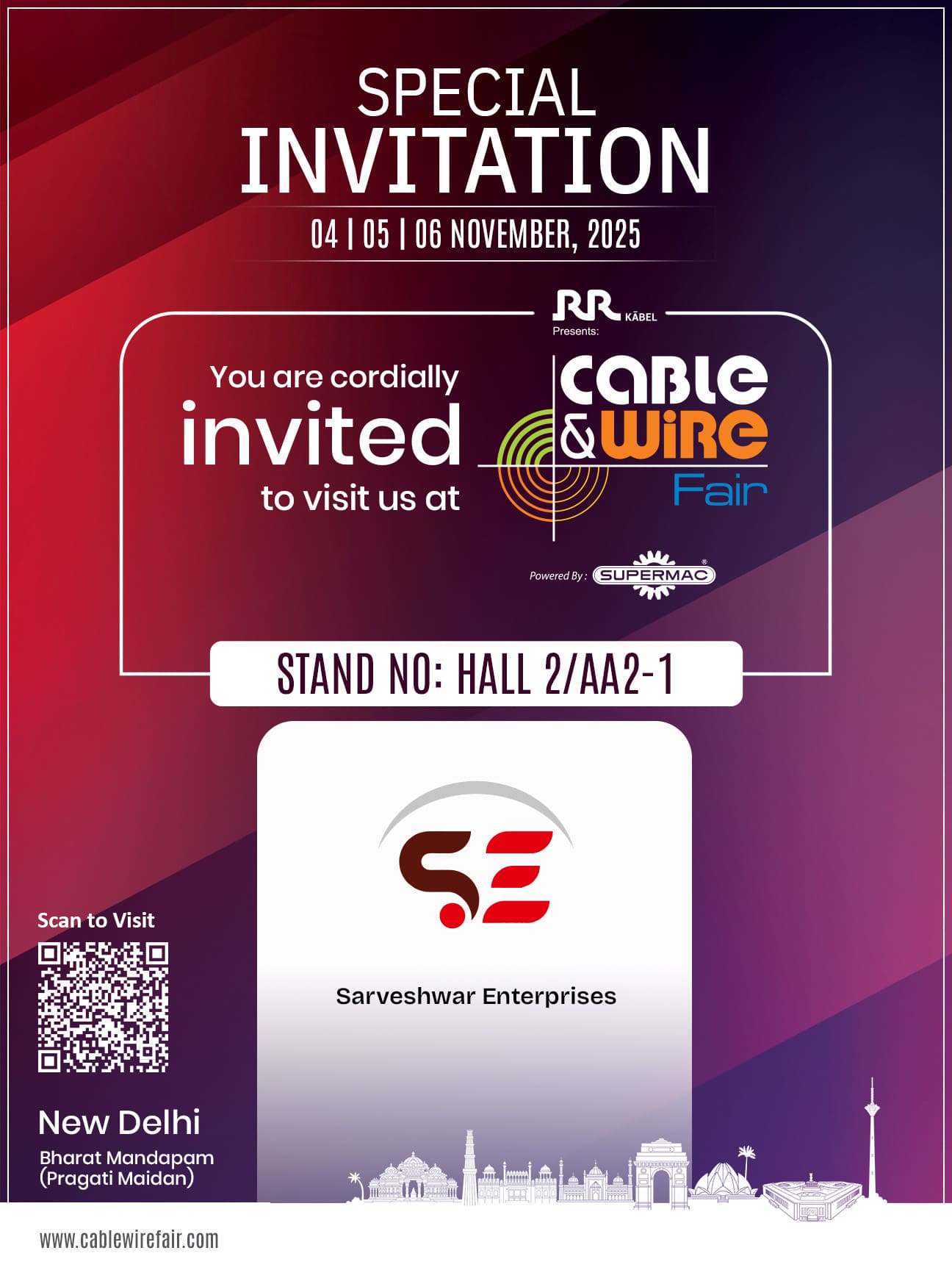


- Home
- About Us
-
Products
.png)
-
Application
.png)
-
Blog
.png)
- Contact us


Different Grade of Aluminum Hydroxide Mechanical Property Compare

Abstract
This study provides a detailed comparison of the mechanical and flame-retardant properties of three aluminum hydroxide grades—KMT-1 (KMT Industrial HK Limited), Albemarle 40CD, and Martin 104L (JM Huber Corporation)—used in a halogen-free flame-retardant formulation. The formulation comprises 35% EVA (7470K), 5% compatibilizer, 0.175% antioxidant, and 60% aluminum hydroxide, tested under controlled conditions (23°C, 40% humidity). Results indicate that KMT-1 achieves the highest elongation at break (227%) and a competitive tensile strength of 12.64 MPa, while Albemarle 40CD exhibits the highest tensile strength (12.84 MPa) and limiting oxygen index (LOI) of 31.8. Martin 104L, however, shows the lowest tensile strength (11.42 MPa) and elongation at break (210%). These findings highlight the trade-offs between flexibility, strength, and processability, offering insights for optimizing material selection in flame-retardant applications.
Keywords: Halogen-free flame retardant, aluminum hydroxide, KMT-1, Albemarle 40CD, Martin 104L, mechanical properties, flame retardancy
1. Introduction
Aluminum hydroxide (ATH) is widely used as a halogen-free flame retardant in polymer composites, particularly in applications such as wire and cable insulation, where safety and environmental concerns are paramount. ATH functions by releasing water vapor when heated, diluting flammable gases and forming a protective char layer. However, the mechanical properties of ATH-filled composites—such as tensile strength, elongation at break, and processability—can vary significantly depending on the grade of ATH used, its particle size, and surface treatment. This study evaluates three commercial ATH grades: KMT-1 (uncoated, KMT Industrial HK Limited), Albemarle 40CD (coated, JM Huber Corporation), and Martin 104L (coated, JM Huber Corporation). By comparing their performance in a standardized EVA-based formulation, we aim to provide actionable insights for manufacturers seeking to balance mechanical performance with flame retardancy.

2. Materials and Methods
2.1 Materials
-
Ethylene-Vinyl Acetate Copolymer (EVA): Grade 7470K with 26% vinyl acetate content, sourced from Formosa Plastics Group. EVA was chosen for its flexibility and compatibility with flame-retardant fillers.
-
Aluminum Hydroxide:
-
KMT-1 (KMT Industrial HK Limited): Particle size 1.87 µm (D50), uncoated, designed for cost-effective flame-retardant applications.
-
Albemarle 40CD (JM Huber Corporation): Particle size 1.45 µm (D50), coated to improve dispersion and matrix interaction.
-
Martin 104L (JM Huber Corporation): Particle size 1.89 µm (D50), coated, optimized for flame-retardant performance.
-
-
Additives: 5% compatibilizer to enhance filler-matrix adhesion, 0.175% antioxidant to prevent thermal degradation during processing.
-
Equipment: Banbury mixer, Plate Curing Press, SY-6210-A Electronic Tensile Machine, Oxygen Index Meter, Melt Flow Index Tester.
2.2 Sample Preparation
The formulation was prepared by mixing 35% EVA, 5% compatibilizer, 0.175% antioxidant, and 60% aluminum hydroxide. The Banbury mixer was preheated to 100–120°C, and materials were mixed for 30 minutes at 200 ± 10°C to ensure homogeneity. The resulting dough was placed in a preheated mold (1 ± 0.1 mm thickness) and pressed using a Plate Curing Press (prepress: 10 MPa; pressure: 10–15 MPa; temperature: 220°C; preheat time: 2 minutes). Samples were cooled to 40–50°C before demolding to prevent warping.
2.3 Mechanical Testing
Tensile properties were evaluated using the SY-6210-A Electronic Tensile Machine at a tensile speed of 250 mm/min. Sample dimensions were 120 × 10 × 1 mm, adhering to GB/T 32129-2015 standards for halogen-free flame-retardant cable materials. The melt flow index (MFI) was measured at 190°C under a 5 kg load to assess processability.
2.4 Combustion Performance Testing
Flame-retardant performance was assessed using the Limiting Oxygen Index (LOI) method per GB/T 2406.2-2009 standards. LOI measures the minimum oxygen concentration required to sustain combustion, with higher values indicating better flame retardancy.
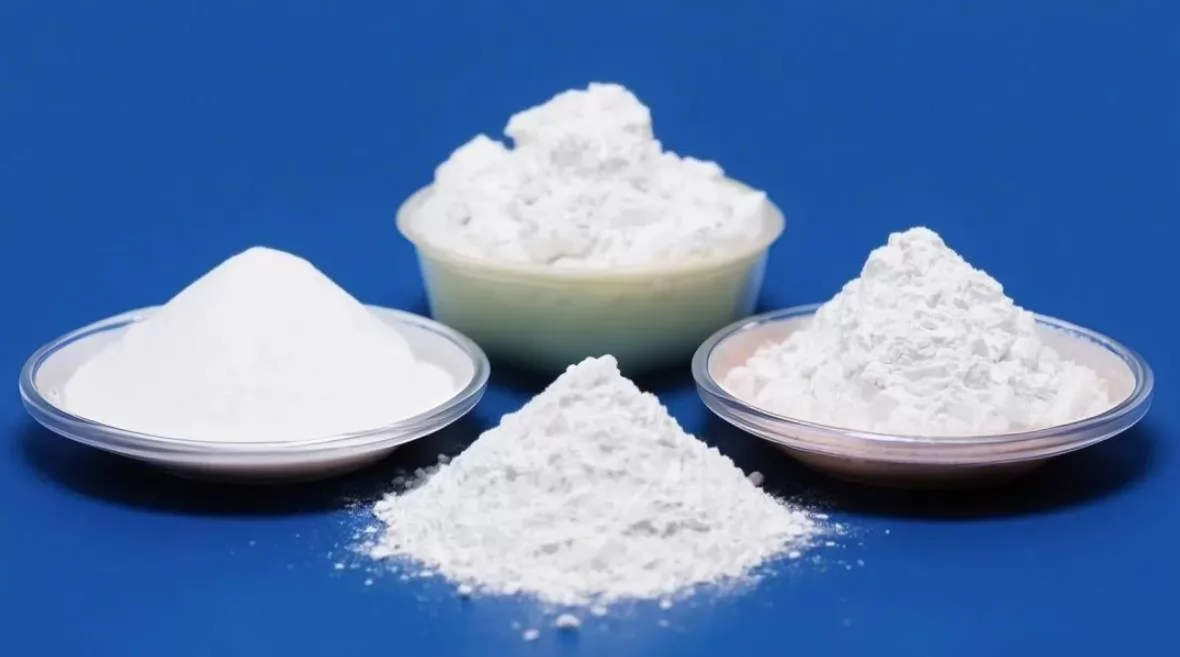
3. Results and Discussion
The formulation details, test conditions, and results are summarized in Table 1, providing a comprehensive overview of the mechanical and flame-retardant properties of the three ATH grades.
Table 1. Formulation and Properties of Aluminum Hydroxide Grades
| Property | KMT-1 | Albemarle 40CD | Martin 104L |
|---|---|---|---|
| EVA (%) | 35 | 35 | 35 |
| Compatibilizer (%) | 5 | 5 | 5 |
| Antioxidant (%) | 0.15 | 0.15 | 0.15 |
| Aluminum Hydroxide (%) | 60 | 60 | 60 |
| Particle Size (D50, µm) | 1.87 | 1.45 | 1.89 |
| Surface Coating | Uncoated | Coated | Coated |
| Melt Flow Index (MFI, 190°C, 5 kg) | 1.9 | 2.3 | 2.3 |
| Elongation at Break (%) | 227 | 212 | 210 |
| Tensile Strength (MPa) | 12.64 | 12.84 | 11.42 |
| Limiting Oxygen Index (LOI) | 30.7 | 31.8 | 30.6 |
| Test Conditions | 20°C, 40% | 20°C, 40% | 20°C, 40% |
3.1 Elongation at Break
As shown in Figure 1, KMT-1 exhibits the highest elongation at break at 227%, compared to 212% for Albemarle 40CD and 210% for Martin 104L. This superior elongation indicates that KMT-1 imparts greater flexibility and ductility to the composite, which is critical for applications such as flexible cables and films that undergo repeated bending or stretching.
Figure 1. Elongation at Break (%) of Aluminum Hydroxide Grades
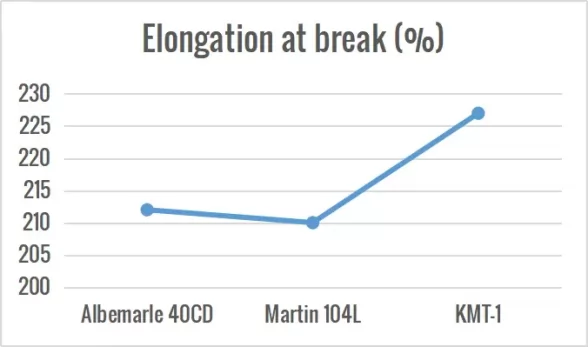
3.2 Tensile Strength
Figure 2 illustrates the tensile strength of the three grades. Albemarle 40CD achieves the highest tensile strength at 12.84 MPa, followed closely by KMT-1 at 12.64 MPa, while Martin 104L lags at 11.42 MPa. The higher tensile strength of Albemarle 40CD can likely be attributed to its smaller particle size (1.45 µm) and surface coating, which improve filler-matrix interaction and stress distribution. KMT-1, despite being uncoated, performs remarkably well, suggesting that its particle size and dispersion properties are well-optimized for mechanical strength.
Figure 2. Tensile Strength (MPa) of Aluminum Hydroxide Grades
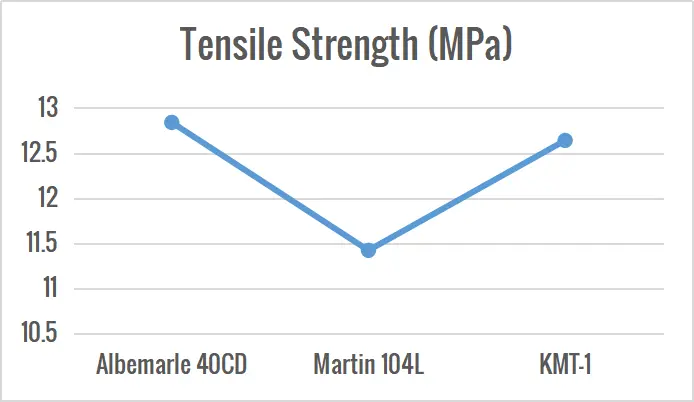
3.3 Flame Retardancy (Limiting Oxygen Index)
The Limiting Oxygen Index (LOI) results reveal differences in flame-retardant performance. Albemarle 40CD has the highest LOI at 31.8, indicating superior flame retardancy, followed by KMT-1 at 30.7 and Martin 104L at 30.6. The higher LOI of Albemarle 40CD may be due to its surface coating, which could enhance char formation and thermal stability during combustion. KMT-1’s LOI, while slightly lower, still meets industry standards for flame-retardant applications (typically LOI > 30), making it a viable option.
3.4 Processability (Melt Flow Index)
The melt flow index (MFI) provides insight into the processability of the composites. Albemarle 40CD and Martin 104L both have an MFI of 2.3, indicating better flow properties during processing compared to KMT-1, which has an MFI of 1.9. The lower MFI of KMT-1 suggests higher viscosity, which may require adjustments in processing conditions (e.g., higher temperatures or pressures) to achieve optimal molding or extrusion.
3.5 Comparative Analysis
-
KMT-1 vs. Albemarle 40CD:
-
Advantages: KMT-1 offers higher elongation at break (227% vs. 212%), making it more suitable for applications requiring flexibility. Its tensile strength (12.64 MPa) is also very close to that of Albemarle 40CD (12.84 MPa), despite being uncoated, which suggests cost-effectiveness without significant performance trade-offs.
-
Disadvantages: KMT-1 has a lower MFI (1.9 vs. 2.3), indicating reduced processability, and a slightly lower LOI (30.7 vs. 31.8), suggesting marginally lower flame retardancy.
-
-
KMT-1 vs. Martin 104L:
-
Advantages: KMT-1 outperforms Martin 104L across multiple metrics: higher tensile strength (12.64 MPa vs. 11.42 MPa), greater elongation at break (227% vs. 210%), and a slightly better LOI (30.7 vs. 30.6). These results position KMT-1 as a superior choice for applications requiring a balance of mechanical and flame-retardant properties.
-
Disadvantages: KMT-1’s lower MFI (1.9 vs. 2.3) indicates poorer processability compared to Martin 104L, which may affect manufacturing efficiency.
-
3.6 Discussion
The results highlight the trade-offs between mechanical performance, flame retardancy, and processability when selecting an ATH grade. KMT-1’s superior elongation at break makes it ideal for applications where flexibility and ductility are critical, such as in flexible cables, automotive components, and construction films. Its competitive tensile strength and adequate LOI further enhance its suitability for such applications, especially considering its uncoated nature, which typically reduces production costs. However, the lower MFI of KMT-1 may pose challenges in high-throughput manufacturing processes, potentially requiring adjustments in processing parameters.
Albemarle 40CD, with its higher tensile strength and LOI, is better suited for applications prioritizing strength and flame retardancy, such as in rigid insulation materials or high-performance coatings. The surface coating likely contributes to its enhanced performance by improving dispersion and reducing thermal degradation during combustion. Martin 104L, while offering good processability, underperforms in mechanical properties, making it less versatile for demanding applications.
Particle size and surface treatment play significant roles in these outcomes. Albemarle 40CD’s smaller particle size (1.45 µm) likely improves filler-matrix interaction, enhancing tensile strength and LOI. KMT-1 and Martin 104L, with slightly larger particle sizes (1.87 µm and 1.89 µm, respectively), may experience more filler agglomeration, which could explain their lower performance in certain metrics. The absence of a surface coating on KMT-1, while cost-effective, may also contribute to its lower MFI and LOI compared to the coated grades.
3.7 Practical Applications
-
KMT-1: Best suited for flexible applications such as wire and cable insulation, flexible films, and automotive components where high elongation and cost-effectiveness are priorities.
-
Albemarle 40CD: Ideal for high-performance applications requiring superior tensile strength and flame retardancy, such as rigid insulation panels, protective coatings, and electronics housing.
-
Martin 104L: Suitable for applications where processability is a priority and mechanical performance requirements are less stringent, such as in general-purpose flame-retardant fillers.
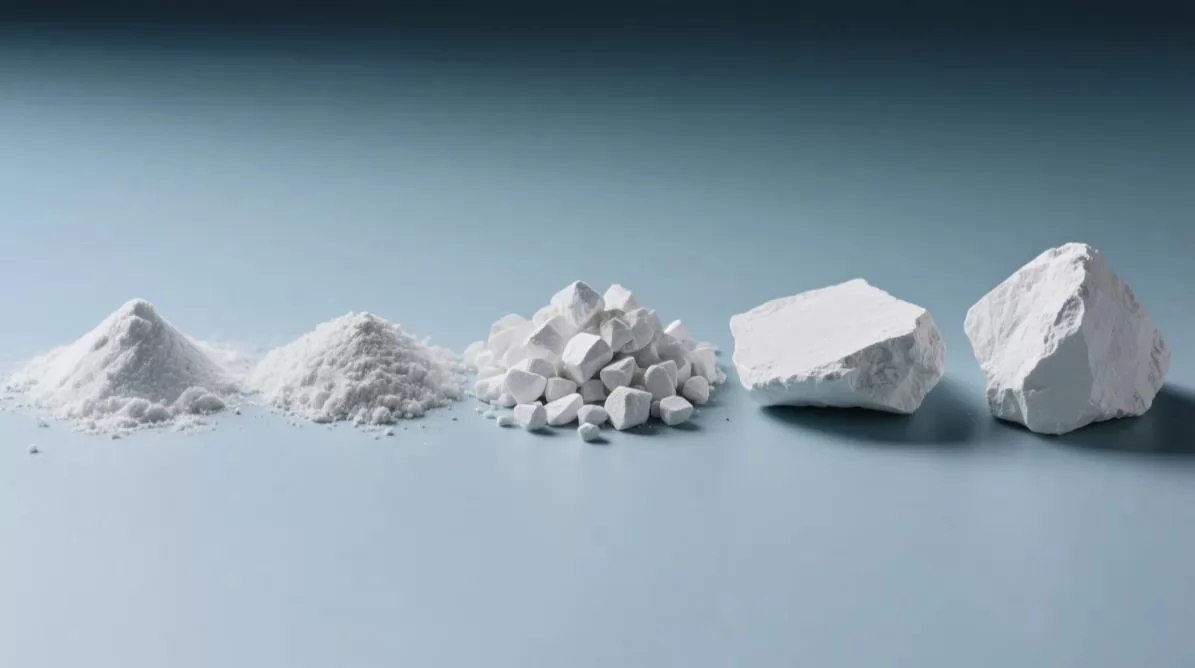
4. Conclusion
This study demonstrates that KMT-1 offers a compelling balance of mechanical properties, particularly in elongation at break (227%), making it an excellent choice for halogen-free flame-retardant formulations requiring flexibility. Its tensile strength (12.64 MPa) and LOI (30.7) are also competitive, especially given its uncoated nature, which may reduce production costs. Albemarle 40CD excels in tensile strength (12.84 MPa) and flame retardancy (LOI 31.8), making it suitable for high-performance applications, while Martin 104L lags in mechanical properties (tensile strength 11.42 MPa, elongation 210%). The choice of ATH grade ultimately depends on the specific application requirements, balancing flexibility, strength, flame retardancy, and processability. Future research could explore the impact of surface treatments on KMT-1 to further enhance its processability and flame-retardant performance.
5. About KMT Industrial HK Limited
KMT Industrial HK Limited, headquartered in Gansu, China, is a leading manufacturer of magnesium hydroxide, aluminum hydroxide, and natural brucite powder for flame-retardant applications. With a focus on innovation and sustainability, KMT Industrial provides high-quality solutions for industries worldwide. For more information, visit www.kmtindustrial.com.
Your Name*
Your Email*
-
2025-Oct-17Top 10 Aluminum Hydroxide Manufacturers in 2025Discover the top 10 aluminum hydroxide manufacturers in 2025, offering high-purity products for flame retardants, pharmaceuticals, and more.
-
2025-Oct-17Guide to Magnesium Hydroxide Flame Retardants for CablesLearn all about the key flame retardants used in the cable and wire industry, including magnesium hydroxide. This detailed guide covers the benefits, applications, and standards for flame retardant coatings. Stay ahead with sustainable and effective solutions from KMT Industry.
-
2025-Oct-17Top 10 Magnesium Hydroxide Suppliers in 2025Top 10 magnesium hydroxide manufacturers and suppliers leading the global market in 2025, detailed report on each supplier is provided.


-

 +86-931-7653361
+86-931-7653361 Room 1212, 1213, Jinhe Building, No. 1264 Beibinhe West Road, Anning District, Lanzhou City, Gansu Province, China.
Room 1212, 1213, Jinhe Building, No. 1264 Beibinhe West Road, Anning District, Lanzhou City, Gansu Province, China. -
Quick Links
-
Products





